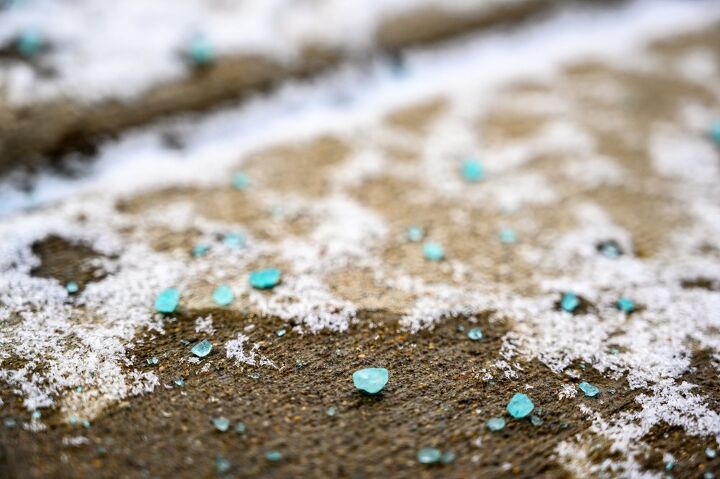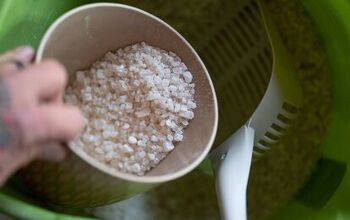When To Salt A Driveway

Nothing is worse than when you can’t get enough traction to get your car out of your icy driveway. Salt is the most common remedy for ice on a driveway, but it’s all about timing. Many homeowners are left wondering when to salt their driveway.
Salt your driveway before it snows to reduce the risk of ice forming on the surface. It will lower the freezing temperature of the water in the snow so that ice is less likely to form. Salt also gives you more traction which makes it safer to walk and drive on the driveway after it snows.
It won’t help if you salt the driveway after it snows because it won’t be able to melt the ice. However, it will still give you more traction which will make it easier to get a good footing on the ice. Follow along as we explore when to salt your driveway and why timing is the most important factor.
Does Salting the Driveway Work?
Salting the driveway does work to help prevent and minimize ice on your driveway. The effect of salt on the water is powerful as it serves to lower its natural freezing temperature. Ice can still form when there is salt on your driveway, but it can delay or prevent the formation at freezing temperatures.
This preventative measure can make it safer to walk on your driveway and move your car. The salt also provides tire traction which is necessary to safely drive when the ground is frozen and slick. Salting the driveway isn’t a guaranteed fix, but it does work except in rare cases with extreme temperatures.
Should I put Salt on my Driveway Before it Snows?
You should put salt on your driveway before it snows because it is a preventative measure. It doesn’t typically work if you put salt on your driveway after the ice has already formed. The salt on your driveway will help prevent ice from forming if you put it down before it snows.
This is why city and county services salt the roads before it snows to reduce the risk of car accidents. The only downside to salting roads and driveways is that it can be harsh on the asphalt. With that said, the risk is worth it when you consider the alternative which is that you won’t be able to get your car out of the driveway.
At What Temperature Does Driveway Salt Work?
Driveway salt can typically work as long as the temperature stays above 20 degrees. The salt won’t work as effectively once the salt drops down to 15 degrees and it isn’t guaranteed to protect your driveway. That doesn’t mean that you shouldn’t salt your driveway if the forecast says that it will be below 20 degrees.
The salt will still have some effect and it’s worth it to do as much as you can to protect your driveway. It will also make your driveway easier to walk on if you have to leave the house. Salt and sand provide traction over ice and snow which makes it safer to walk on.
When Should you not Salt Your Driveway?
You should not salt your driveway if the temperature hits 10 degrees or drops below zero. The salt could bind together and make it take longer for the ice to melt in that case. Ice will still melt eventually, but it may cause the melted ice to refreeze and form clumps if the temperature stays below freezing.
You should also avoid salting your driveway if there is no ice and snow in the forecast. Salt is bad for driveways, but it’s worth the risk when you know that ice will form. However, you don’t want to risk damaging your driveway when there is no reason to unless you need the extra traction.
Does Rain Wash Away Salt?
Rain does wash away the salt on your driveway, but it won’t get rid of all of it. That is why you will still find residue on your driveway after snow and ice melts, or it rains. Luckily, you can remove the unpleasant salt residue with household items such as vinegar and dish soap.
All that you need to do is mix 1 cup of vinegar with a few squirts of dish soap in a gallon of water. Make sure that the water is warm or else this process won’t be as effective. Use a mop, broom, rag, or sponge to scrub the salt stains off of the driveway.
If that doesn’t work, you can use special products like Star Brite and Salt-Away. This will help to remove the majority of the salt stains on your driveway, but there may still be some residue left behind.
Sand or Salt for Driveway?
Salt is much better for your driveway than sand because it helps to melt ice. Sand doesn’t melt ice, but it does help to add traction to the surface. Both options are great for making slick surfaces safer to walk and drive on.
However, sand it is better to use sand on outdoor stairs and walkways to prevent falls. Salt is more about stopping ice from forming, but it can provide traction as well. You can use sand and salt in conjunction to be extra safe, but you will have more to clean up after the ice melts.
Is Putting Salt on Your Driveway bad?
Putting salt on your driveway isn’t bad, but it can weaken it over time. The main risk with putting salt on your driveway is that it will spill over into your soil when the ice melts and it mixes with water. This is bad for your yard and can kill plants in its path.
Some homeowners use kitty litter and even coffee grounds as an alternative to salt. Heated mats are the best alternative if you want to protect your driveway without damaging the soil with runoff.
Related Guides

Nick Durante is a professional writer with a primary focus on home improvement. When he is not writing about home improvement or taking on projects around the house, he likes to read and create art. He is always looking towards the newest trends in home improvement.
More by Nick Durante



























